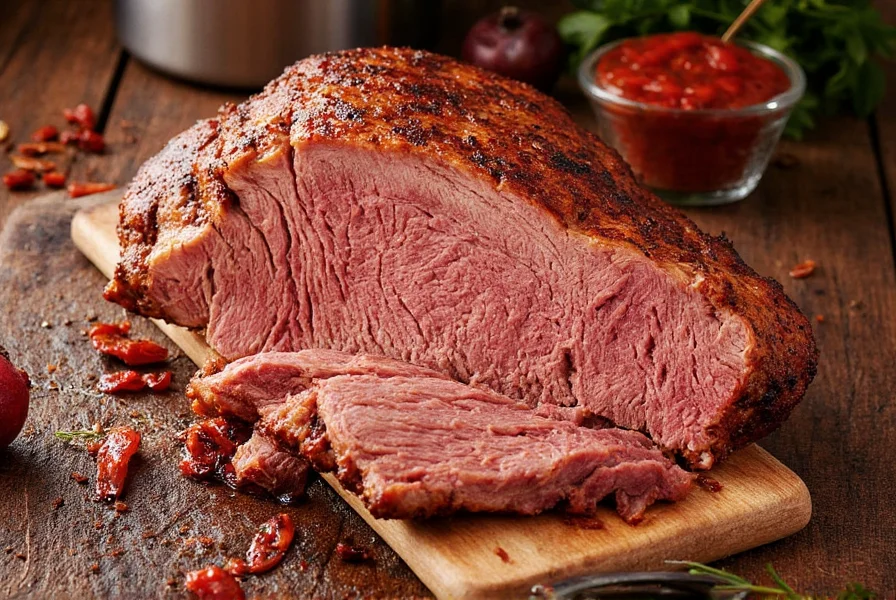| Ingredient | Amount | Role |
|---|---|---|
| Beef Brisket | 10-12 lbs | Primary protein |
| Paprika | 2 tbsp | Color and mild sweetness |
| Chili Powder | 1 tbsp | Heat and complexity |
| Garlic Powder | 1 tbsp | Umami depth |
| Onion Powder | 1 tbsp | Sweetness and aroma |
| Cumin | 1 tsp | Earthy warmth |
| Black Pepper | 1 tsp | Peppery bite |
| Kosher Salt | 1 tbsp | Balances flavors |
| Olive Oil | 2 tbsp | For searing |
Ready for restaurant-quality brisket without a smoker? This complete oven brisket recipe delivers tender, smoky results with precise measurements and foolproof steps. No guesswork—just perfectly cooked meat every time.
Why This Recipe Works
Unlike generic brisket recipes, this guide includes exact spice measurements, temperature control tips, and science-backed techniques to break down connective tissue. The 6-8 hour low-and-slow cooking process ensures maximum tenderness while preserving moisture.
Equipment Checklist
- 10-12 lb beef brisket (flat or point cut)
- Oven-safe Dutch oven or roasting pan
- Instant-read meat thermometer
- Aluminum foil
- Sharp knife for trimming
Step-by-Step Oven Brisket Recipe
- Trim and Prep: Pat brisket dry. Trim excess fat to 1/4-inch thickness. Apply spice rub evenly on all sides.
- Sear: Heat olive oil in pan over medium-high. Sear brisket 3-4 minutes per side until deeply browned.
- Rest: Let meat rest 30 minutes to allow spices to penetrate.
- Slow Cook: Preheat oven to 275°F (135°C). Place brisket fat-side up in pan. Cover tightly with foil. Cook 6-8 hours until internal temperature reaches 200°F (93°C).
- Rest Again: Remove from oven. Wrap in fresh foil. Rest 1 hour before slicing against the grain.
Pro Tips for Perfect Results
- Temperature Check: Use a thermometer—don't rely on time alone. Brisket is done when fork-tender at 200°F.
- Moisture Control: Baste with pan juices every 2 hours if uncovered during cooking.
- Smoke Flavor: Add 1 tsp liquid smoke to the pan for authentic barbecue notes.
- Storage: Store leftovers in cooking juices for up to 4 days. Reheat covered in 300°F oven with broth.
Common Mistakes to Avoid
- Skipping the Rest: Resting allows juices to redistribute. Cutting too soon causes dryness.
- High Heat: Cooking above 275°F toughens connective tissue.
- Insufficient Rub: Use all specified spices for balanced flavor profile.
Frequently Asked Questions
How long does it take to cook brisket in the oven?
Brisket typically requires 6-8 hours at 275°F (135°C) for a 10-12 pound cut. The cooking time depends on the size of your brisket, but the best indicator of doneness is internal temperature (200°F/93°C) and fork tenderness, not just time.
Why is my oven brisket tough?
Brisket contains a lot of connective tissue that needs sufficient time to break down. If your brisket is tough, it likely needs more cooking time. Ensure you're cooking at a low temperature (275°F) for the proper duration until fork-tender. Rushing the process by increasing temperature will result in tough meat.
Should I cook brisket fat side up or down?
Always cook brisket fat side up. As the fat renders during the long cooking process, it bastes the meat naturally, keeping it moist and adding flavor. Cooking fat side down won't allow this self-basting effect to happen properly.
How do I store leftover brisket?
Store cooled brisket in an airtight container with some of the cooking juices for up to 4 days in the refrigerator. For longer storage, wrap tightly in foil and place in freezer bags with the air removed; frozen brisket maintains quality for up to 3 months. The cooking juices help preserve moisture when reheating.
What's the best way to reheat brisket without drying it out?
The best method is to place slices in a baking dish with some cooking juices or beef broth, cover tightly with foil, and warm in a 300°F oven until heated through (about 20-30 minutes). Avoid microwaving as it tends to dry out the meat. For sandwiches, steaming the slices briefly can help restore moisture.
Can I make oven brisket without a spice rub?
While you can technically cook brisket with just salt and pepper, the spice rub is what gives brisket its distinctive flavor profile. The combination of spices creates a flavorful bark on the exterior that complements the rich meat. A good rub is essential for authentic barbecue flavor, even when cooking in the oven.
Do I need to wrap my brisket in foil during cooking?
Yes, wrapping in foil (often called the "Texas crutch") helps retain moisture and can speed up the cooking process once the meat has developed a good crust. Wrap when the internal temperature reaches about 160°F, or when the meat has a deep brown crust, to prevent drying during the remaining cooking time.











 浙公网安备
33010002000092号
浙公网安备
33010002000092号 浙B2-20120091-4
浙B2-20120091-4